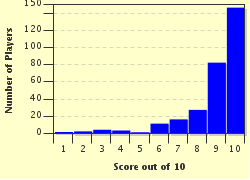Quiz Answer Key and Fun Facts
1. The Easter Bunny needs to find a new container for his eggs, and sees a man paddling down a river in Wales in a round boat that looks like a covered basket. The man explains that boats like his are made of woven willow or ash and covered with cloth painted in bitumen to keep the water out. The man says he sometimes puts leeks in his boat, which only makes the Easter Bunny wonder why it doesn't sink so he decides to stay on dry land. What round boats are traditionally associated with Wales?
2. The Easter Bunny is looking for a new basket and sees something flying overhead that looks just the thing! It's a basket dangling from a balloon and there's a man inside! The Easter Bunny asks the man if he can borrow the basket. "This basket is very old," the man replies, "I am …tienne Montgolfier, the first man to fly above the earth, and I designed this balloon with my brother, Joseph." What country, the northern coastline of which is on the English Channel, is the Easter Bunny in now?
3. The Easter Bunny considers repairing his basket with matting and knocks on the door of a Japanese house. The owner bows and invites him to come in but asks him to remove his shoes first. He explains that in the room guests use the floor is covered with mats made of rice straw and rushes woven together, but these mats are easily spoiled by the hard soles of shoes. What do the Japanese call this type of mat?
4. The Easter Bunny thinks he might have to sail the oceans looking for a new basket, so he goes to the docks where a Norwegian called Thor Heyerdahl is building a boat from woven papyrus. The Easter Bunny asks Heyerdahl what countries he went to on his previous voyages. Heyerdahl replies that on his most famous voyage he sailed a raft across the Pacific from Peru to Polynesia. What was the name of Thor Heyerdahl's famous raft?
5. The Easter Bunny is so stressed about the holes in his basket he decides that he needs to relax and settles down to watch some sport. Suddenly he realises that he is watching a game originally played by Native Americans, throwing the ball to each other using sticks that have a woven mesh at the end. What sport is the Easter Bunny watching?
6. Finding something to replace or repair his basket is proving hard work for the Easter Bunny who is trudging down a lane in the English countryside. Suddenly he sees a man spreading great bundles of straw on to the roof of a cottage and fixing them with pegs, while another man is weaving a pattern in the straw along the ridge of the roof. What sort of roof is this?
7. The Easter Bunny is dreaming of a new basket when he sees a huge man woven from wicker being set alight by some Druids and it looks as though there are real people inside being sacrificed! The Bunny realises he is looking at The Wicker Man, described by Julius Caesar in his famous book about war in France which was then divided into three parts. However, Caesar didn't call it France, what did he call it?
8. The Easter Bunny visits China looking for a new basket, but as he walks down the road from the airport he realises he has to cross a deep canyon, with a raging river down below! In order to get across he needs to use the narrow suspension bridge which has been woven from a tall local grass. The Bunny hopes that pandas won't eat the bridge before he gets across. What is the bridge made from?
9. The Easter Bunny goes to New Zealand to see if they have anything that could be woven into a basket. He is greeted by Maori chiefs wearing some splendid woven cloaks which they say were made from a plant. The Easter Bunny decides to look for this plant but what is the English name for it?
10. The Easter Bunny makes one last effort to get a new basket and goes to Egypt where he knows they have woven things for centuries. He stands on the bank of the Nile and sees a basket in the bulrushes - it would be just the thing! He wades out to pull the basket ashore when he realises there is a baby inside. While the Bunny is deciding whether to run off with the basket, the Pharaoh's daughter arrives and decides to adopt the baby. What baby in the Bible was found in a basket on the Nile?
Source: Author
flopsymopsy
This quiz was reviewed by FunTrivia editor
Pagiedamon before going online.
Any errors found in FunTrivia content are routinely corrected through our feedback system.


